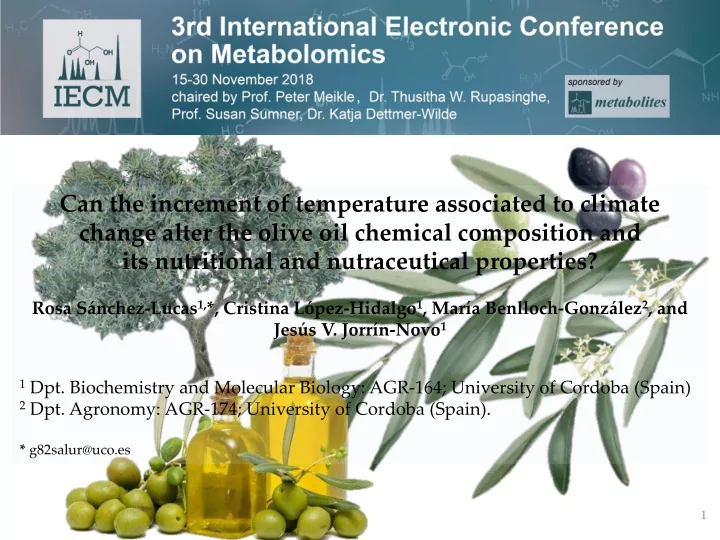

Can the increment of temperature associated to climate change alter the olive oil chemical composition and its nutritional and nutraceutical properties? Rosa Sánchez-Lucas 1, *, Cristina López-Hidalgo 1 , María Benlloch-González 2 , and Jesús V. Jorrín-Novo 1 1 Dpt. Biochemistry and Molecular Biology: AGR-164; University of Cordoba (Spain) 2 Dpt. Agronomy: AGR-174; University of Cordoba (Spain). * g82salur@uco.es 1
Introduction • Olive tree as experimental system • Strategic crop for Spain. • 3 major varieties. Arbequina Hojiblanca Picual Olive oil production (1000 t) 2
Olive oil as nutraceutical food product • Olive oil = olive juice without chemical extraction or aditives. • High content FA (unsaturated) and low content FFA • High content of polyphenols (antioxidant power) . • Different vitamins, sterols, pigments … 3
Thermal stress • Climate change scenarios • Thermal increase • Mediterranean area with several damages. 4
Objectives I. To study how thermal increase (+4ºC) affected to the development, maturity and organoleptic properties of olive fruits through phenology, morphometry and biomolecular approaches. II. Metabolite profiles of ripening stages: i) green fruits; ii) turning red; iii) and purple pigmentation, were analyzed by UHPLC/qTOF strategy. III. To identify the principal metabolites affected by thermal increase and that play a role in the quality of the oil (organoleptic and nutraceutical characteristics). 5
Materials and Methods +4ºC Treatment Ambient Temperature Experimental design Temperature Pobe and AT+4ºC: Datalogger Open Top Chambers • 8 OTC indoor trees (OTC) AT: Ventilation Grill • 8 Control outdoor trees Campaign 2015/2016 Injection Outdoor Air Resistances Turbine 6
Phenology • Growth • Flowering processes [1] • Ripening processes Morphology and chemical composition • Total production • Fruit size • Fat yield • Anthocyanins and polyphenols contents Metabolomic approaches • 5 ripening stages were collected • 3 ripening stages were selected 7 [1] Benlloch-González et al. (2018). Scientia Horticulturae, 240:405-410.
Metabolomic analysis by UPLC-MS/MS Metabolite extraction: methanol: chloroform: water (5:2:2) protocol[2] Tissue homogeneization Extract SpeedVac desecation Statistical analysis Identification and Quantification Metabolites methanol reconstitution Spectra analyses UHPLC/qTOF- MS analysis (UPLC Acquity H-Class Xevo G-2) 8 [2] Valledor et al. (2014.). Plant J. 79, 173 – 180
Results Perfect Flowers Total Production/tree Fruit size Pulpe/pit Fat yield (% (% ) (Kg FW) (g FW/nº fruits) (g FW/g FW) DW) AT 6.0 ± 1.4 a* 5.8 ± 0.7 a** 5.7 ± 0.1 a** 9.0 ± 0.3 a** 54 ± 1 a* AT+4ºC 0.5 ± 0.2 b* 0.3 ± 0.0 b** 3.2 ± 0.2 b** 3.7 ± 0.3 b** 36 ± 5 b* 9
~ 97.000 signals 9877 annotated compounds ~700 metabolites identified 10
~ 49.000 signals 1162 annotated compounds ~290 metabolites identified 11
12
193 metabolites were differents at green ripening stage Fold Change │ 2 │ 13
177 metabolites were differents at turning-red ripening stage Fold Change │ 2 │ 241 metabolites were differents at purple ripening stage Fold Change │ 2 │ Functional categorization was carried out manually 14
Conclusions • Around 800 metabolites were identified by UHPLC/qTOF MS strategy using a restricted parameters. • Present in 2/3replicates and absent in blank • With description known and fragmentation spectra • Quality control reproducibility • Around 200 metabolites/ripening stage present differences (FDR<0,05) between AT and AT+4ºC treatments. • The major ripening processes affected by +4ºC were fatty acids synthesis, plant cell wall degradation, and terpene, phenylpropanoids and flavonoids biosynthesis. • The results suggest that global warming will be affect the ripening processes modifying the fruit characteristics and the final oil quantity and quality. 15
Perspectives • Analysis by RT-qPCR of 103 gene expressions • Lipid metabolism • ABA- ethylene-AIA response • Plant wall degradation • Anthocyanin biosynthesis • Olive secondary metabolites • Analysis of flowering and ripening processes by proteomics assays • Extension of the study with other varieties 16
Dpt. Biochemistry and Molecular Biology; AGR-164 Jesús Jorrín Novo Ana Maldonado Alconada MªCarmen Molina Gómez Mª Dolores Rey Santomé MªÁngeles Castillejo Sánchez Victor M. Guerrero Sánchez Cristina López Hidalgo Isabel Gómez Gálvez Fabiola Santos Rodríguez Dpt. Agronomy; AGR-174 Manuel Benlloch María Benlloch González Acknowledgements: Consejería de Economía y Conocimiento de la Junta de Andalucía “Incentivos a Proyectos de Investigación de Excelencia” (Ref. AGR/7152). FPU grant supported by the Ministry of Education of Spain (FPU14/00186). 17
Thanks for your attention 18
Recommend
More recommend